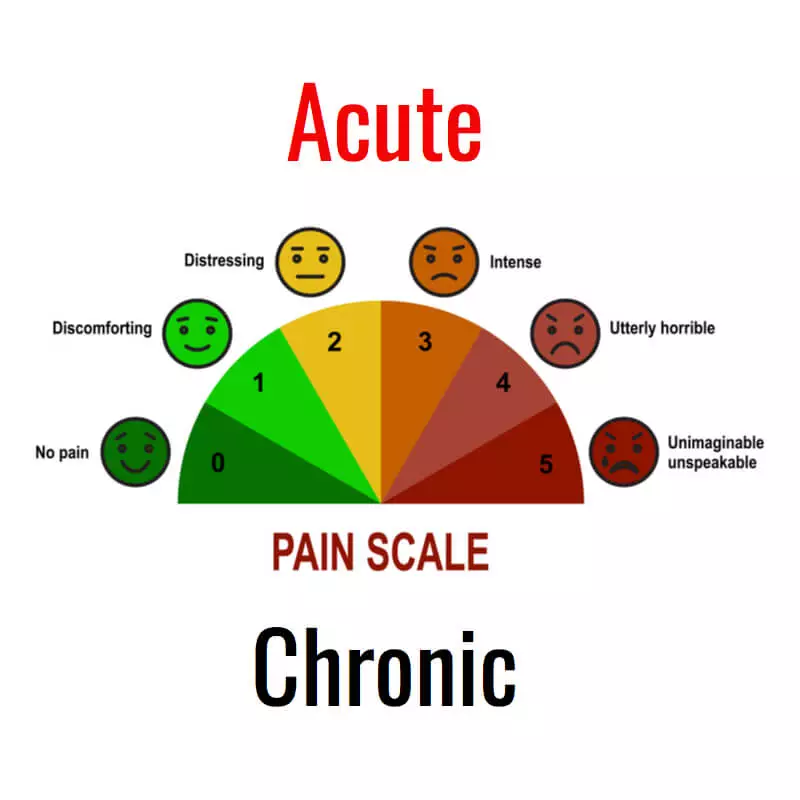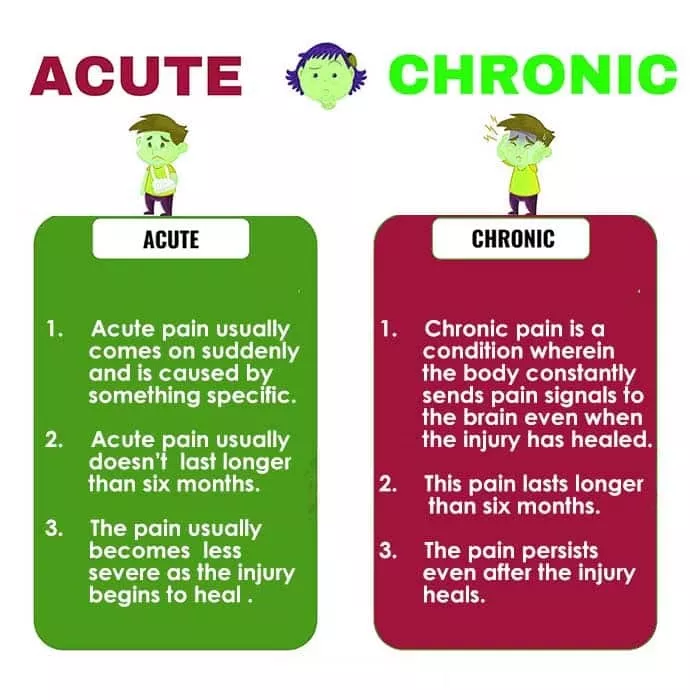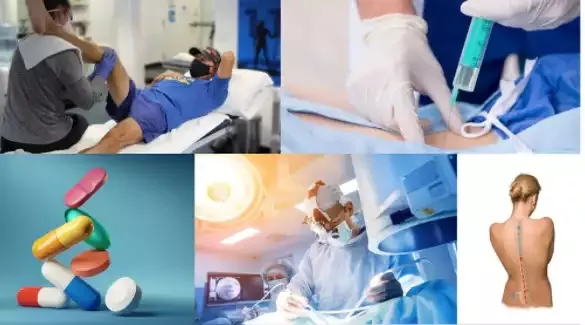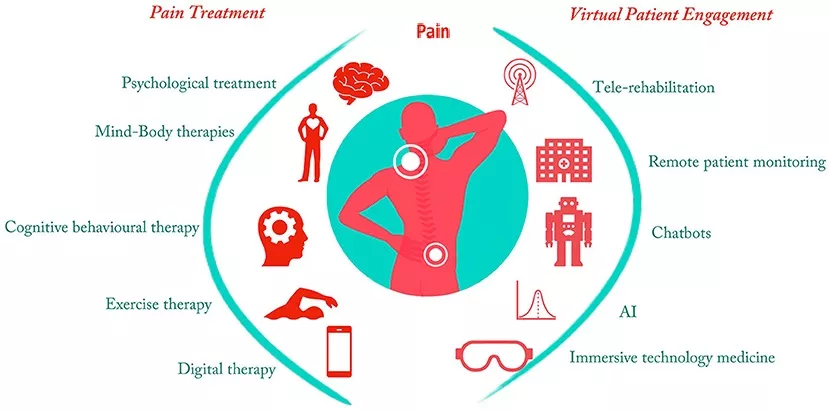Pain is a terrible sensory and emotional experience for the most part emerging from real or potential tissue harm. Intense pain can be a troublesome clinical issue to diagnose and treat. It could be brought about by numerous occasions or conditions. Symptoms can last hours, days, or weeks and are normally connected with tissue injury, inflammation, a surgical technique, labor, or a concise sickness process.
Most pain subsides after injury mend or an illness runs its course. Each one as well as their pain is unique. The best way to manage your pain might differ from what works for others. Pain management is a process to find the best plan that suits your needs. Your primary care physician (PCP) can try a combination of things to manage your condition. Your doctor together with you can tweak your program based on your situation and what needs more help
HOW IS ACUTE PAIN DIFFERENT FROM CHRONIC PAIN?
Pain is for the most part viewed as acute when it endures less than 90 days. Acute pain normally begins out of nowhere because of an injury — a cut, bruise, burn, broken bone, or pulled muscle, for instance. Acute pain can likewise be brought about by a fever or infection, work contractions, and feminine cramps. Pain that goes on for quite some time or longer is viewed as chronic pain and can be brought about by conditions like joint inflammation, back issues, shingles, migraines, and neuropathy (a condition that can result from diabetes and cause numbness or tingling, pricking sensations or muscle shortcoming).
Some of the time acute pain becomes chronic. A sports injury that isn’t diagnosed and treated appropriately can lead to long-haul damage to joints or muscles. Certain wounds can cause nerve damage that leads to continuous pain. Indeed, even postoperative pain that isn’t overseen accurately can lead to chronic pain. In this way, acute pain must be precisely diagnosed and successfully treated.
EVERY PAIN IS DIFFERENT
To make your pain management plan, your PCP will initially see if you have abrupt (“acute”) or long haul (“chronic”) pain.
- Acute pain: This starts abruptly and typically feels sharp. Broken bones, burns, or cuts are exemplary models. Pain subsequent to conceiving an offspring or surgery is as well. Acute pain might be mild and last one minute. Or on the other hand, it very well might be severe and keep going for weeks or months. By and large, acute pain doesn’t endure longer than a half year, and it stops when its underlying reason has been dealt with or has healed. On the off chance that the issue that causes momentary pain isn’t dealt with, it might prompt long haul or “chronic” pain.
- Chronic pain: This endures longer than a half year, frequently regardless of the way that an injury has healed. It might keep going for quite a long time. These may include:
- Headaches
- Low back pain
- Cancer pain
- Arthritis pain
- Pain caused by nerve damage
It can cause tense muscles, issues with moving, a lack of energy, and changes in hunger. It can likewise influence your feelings. Certain individuals feel depressed, angry, or anxious about the pain and injury returning. Chronic pain doesn’t necessarily in all cases have an undeniable physical cause. WHAT TREATMENT METHODS MAKE YOU FEEL BETTER?
WHAT TREATMENT METHODS MAKE YOU FEEL BETTER?
- Being active: Low-intensity exercise is better than rest for pain management. Exercise is a stress reliever for certain individuals, which is critical to managing when you have chronic pain.
- Physical and occupational therapy: Take your recovery to a higher level with these medicines. In physical treatment, you’ll zero in on the specific muscles you want to fortify, stretch, and recuperate from injury. Your PCP may likewise suggest word-related treatment, which centers around how to do explicit errands, such as strolling all over steps, opening a container, or getting in and out of a vehicle, with less pain.
- Massage therapy: This is not a cure; however, it can help reduce pain briefly and ease tension in your muscles.
- Relaxation: Meditation and profound breathing are two methods to attempt. You could likewise picture a serene scene, do some gentle stretching, or stand by listening to music you love. Another procedure is to examine your body gradually to you and deliberately attempt to relax each piece of your body, individually, from head to toe.
- Complementary treatments: These include acupuncture, biofeedback, and spinal manipulation. Biofeedback trains you to control how your body responds to pain. In case you get spinal manipulation, a healthcare provider purposes their hands or a device to change your spine so you can move better and have less pain.
ARE THERE DEVICES THAT HELP?
There are no products that completely take away your pain, there are some that you and your doctor could consider.
- TENS and ultrasound: TENS, uses a device to send an electric current to the skin over the area where you have pain. Ultrasound sends sound waves to the places you have pain. Both may offer relief by blocking the pain messages sent to your brain.
- Spinal cord stimulation: An implanted device transports low-voltage electricity to the spine to block pain. On the off chance that your primary care physician believes it’s a choice, you could involve it for a time for testing before you get surgery to have it permanently implanted. Much of the time, you can return home that very day as the procedure.
WILL THE MEDICINES HELP IN PAIN MANAGEMENT?
Your primary care physician will consider what’s causing your pain, how long you’ve had it, how intense it is, and what prescriptions will help. Medicines and sometimes even surgery can help reduce the pain. Some of these medicines include:
- Anticonvulsants (medications that prevent seizures) for nerve pain.
- Antidepressants such as tricyclic antidepressants.
- Corticosteroid.
- Muscle relaxers.
- Nonsteroidal anti-inflammatory drugs (NSAIDs) or acetaminophen.
- Topical products (applied to the skin) that contain pain relievers or ingredients that create soothing heat or cold.
- Opioids (narcotics) – Opioids can be addictive, and you can build up a tolerance to them over time. Because of this, healthcare providers usually try other pain treatment options before prescribing opioids.
- Sedatives to help with anxiety or insomnia.
OUTLOOK
The complications of pain whether it is acute or chronic are serious. Because of this, it’s essential to look for clinical consideration assuming you’re encountering chronic pain. There are numerous choices for pain treatment and management. While it might require a long time to track down the right combination of therapies that work for you, it merits undertaking.
Our experts at Specialty Care Clinics will take care of your health and help you recover from chronic and acute pain. Speciality Care Clinics has cutting-edge medical care to diagnose any serious and chronic medical problems. Call us at (469) 545-9983 to book an appointment with our specialists.


